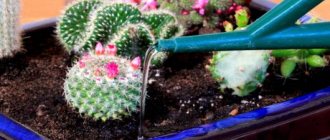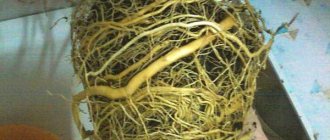Cacti are those plants that are firmly entrenched in the homes of gardeners. The original shape and appearance make this flower stand out from others. Despite the fact that caring for many species is quite simple, gardeners, and especially beginners, are concerned about the question of how to transplant a cactus into another pot.
People know that if they make even the slightest mistake in carrying out the procedure, the plant may stop growing or even begin to deteriorate. There have been cases (and they are not uncommon) when replanting affected flowering, or rather its absence. If you want no troubles to arise after the manipulation, you should follow all the rules.
Important! Young cacti that were just purchased in flower shops deserve great attention. Their transplantation must be treated properly.
Having spent just a few minutes learning how to properly transplant a cactus, in the future this procedure will be performed almost automatically.
How to replant cacti at home
Replanting a purchased cactus is perhaps one of the most difficult manipulations, especially when you are doing something like this for the first time. The reason is that you need to be careful not to prick yourself, and also not to damage the young plant. It is probably difficult for someone to believe that even a small scratch on a cactus can be fatal for it, but it is so. In addition, an accidentally damaged root system, deepened into a moist substrate, will lead to the development of rot and death of the specimen. The same applies to active and unnecessary watering immediately after transplantation.
If you have a cactus growing at home, but it has never been replanted, it is important to know when to carry out the procedure. Although the flower itself will signal this.
This is about:
- Protruding "crown". If the “cap” already protrudes considerably beyond the edges of the flowerpot, then this is a signal that it is time to purchase a new pot and replant.
- Roots protruding from drainage holes. This is a “screaming” sign, which is better not to lead to.
- Cactus wrinkling, growth retardation, loss of elasticity or color.
Sometimes the reasons that indicate that a cactus transplant is necessary are so diverse that they cannot be listed. You just need to observe the condition of the plant and then it will become clear what it is missing.
Some inexperienced flower growers insist that cacti are not replanted after purchase, assuring that they “sit” in good soil and there is no need to further injure the plant. Actually this is not true.
Few people know, but most of these copies that are sold in stores are Dutch. In order for the plants to have a decent appearance and attract buyers with their beauty, they are grown in greenhouses, but at the same time they use the strongest growth stimulants. You won’t be able to do the same at home, although you don’t need to achieve this. This means that being in the soil in which the flower was, but placed in different conditions, it will die. However, that's not all. Often, multiple pests appear in the substrate, which are not always noticeable. Therefore, there is a possibility that, some time after purchase, the cactus will wither and many of the flowers in the house will die. Therefore, the cactus can not only be replanted, it must be done without fail, whether you want it or not.
Choosing the right pot
In order for the cactus transplant to be successful, you need to select a pot suitable for a particular plant. Children need to be planted in small pots, large and long cacti - in a larger container (at least 1-2 centimeters larger than the previous pot). You can choose any pot to your taste, but the most suitable is a vessel with a drainage hole at the bottom to drain excess liquid.
A large flower cannot grow in a small pot, so the statement that cacti like close quarters is wrong.
A plastic pot is most suitable because the soil in it dries evenly, while in a clay pot the walls dry out first and then the center. Young roots will be drawn to the walls of the pot for moisture and may be injured due to overheating and uneven drying of the soil.
If the plant has a well-developed, dense root, then you need to choose a shallow but wide pot for it, and in the case of a thin but long root - a high but narrow container.
How to transplant cacti
If the purchased specimen has wet soil, you should not touch the plant until it dries. Often 7-10 days are enough for this. All this time, the flower should be in the so-called “sump” - a place where there are no other indoor plants.
After this, the following procedures are performed step by step:
- A flower is removed from the flowerpot and carefully examined. Particular attention should be paid to the root system, which many pests love so much.
- Rotten or spoiled roots are cut off. If any problems were noticed with the stem: it has darkened a little or someone has also eaten it, then these areas need to be trimmed. In this case, the cut areas should be treated with activated carbon.
- Next, the cactus is washed well with hot water. It would be a good idea to add an insecticide to the container, which will make it possible to get rid of the disease, if any. In the case when the cactus does not look very healthy, not only the roots, but also the entire flower are washed with water.
- After “taking a bath,” the cactus should be given time to dry thoroughly. True, there is no need to place the flower on its side; it is advisable to place it in a vertical position. Usually 4-5 days are enough for complete drying.
- You need to purchase a special soil mixture in advance, fill the pot with it, and then plant the cactus there. There is no need to water the plant immediately; this can be done after a few days.
Important! In order to save money, there is no need to replant the cactus in the same soil with which it was sold, even if it appears to have a good texture and pests are not visually visible in it.
We can say with almost 100% certainty that this will lead to the death of the plant.
If you don’t want to purchase a ready-made substrate, but want to do everything yourself, then this can be done.
To do this, you need to take some components in equal quantities and mix them well.
This is about:
- gravels;
- fine brick chips;
- washed sand;
- loamy soil;
- crushed charcoal.
Further care of the transplanted cactus
After the transplantation procedure, the roots of the cactus must certainly dry out and become stronger, so it is necessary to wait a while with watering. For one week, relatively moisture-loving members of the family (such as Cereus, Hylocereus, Trichocereus, etc.) should not be watered. For cacti that are more sensitive to moisture, watering should be postponed for 2-3 weeks. For the same period, wet procedures should be abandoned if the plant had signs of disease and lost a significant number of roots during replanting.
To prevent the plant from becoming dehydrated, it can be covered with plastic wrap for a while. This will increase the humidity.
In winter, it is better not to water the flowers, but to place them in a warm place for 5 days. Then you need to provide a cool rest.
When resuming watering, it is important not to direct the stream at the root collar; there should not be a lot of water. It is recommended to heat the water to 50°C. Transplanted plants should not be immediately placed in direct sunlight. They will better tolerate the stress associated with changing soil for several days in a partially shaded place. Large specimens will need support (until the root system is well established in the substrate).
If, during transplantation, signs of any diseases and pests were detected and eliminated on the roots, then this specimen should be temporarily isolated from others.
Remember!
The first month after transplantation is very important, when the plants intensively grow all their organs. In addition to new roots and thorns, they acquire flower buds. At this time, it is not recommended to disturb plants without special reasons.
Important nuances
Not only a small or large cactus needs to be replanted, but also an old specimen. Typically, such plants are replanted once every few years. Although in reality it all depends on the specific species. There are cacti that, after a few years, cannot be manipulated at all, unless there is an urgent need for it, when the plant is sick or is affected by pests, for example.
The entire process of transplanting old plants occurs as follows:
- Prepare the soil mixture or buy it ready-made.
- A pot is selected (for adult plants, it is not necessary to buy a larger pot; the size that you have is suitable).
- The cactus is replanted, this is done as with young species.
- Appropriate care is provided.
It is still necessary to replant cacti at home more for the purpose of prevention, in order to protect the plant from attack by parasites.
Rules of care after transplantation
- It is necessary to protect the transplanted plant from direct sunlight; it is better to place it in partial shade. Optimum air temperature 20-25C
- There is no need to over-moisten the cactus soil.
- You can feed the cactus once a month.
AllaAuthor of the article
Did you like the article?
Share with your friends:
Security measures
The cactus is an unusual flower, if only because it has spines. Considering that there are specimens in which these spines are very sharp, you need to be extremely careful and careful not to prick yourself or hurt your hands. In this case, it is best to use thick gloves made of rubber, leather or regular thick material. Some gardeners, in the absence of such, simply wrap the plant in several layers of soft paper. In this case, dishwashing sponges are also suitable.
If you need to plant a tiny shoot, you can take it with your bare hands. Although in this case you need to be careful not to damage the plant itself - so fragile and still tender.
Methods for planting cactus without roots
If you separate small pieces from an adult plant, you can get a shoot or a baby. Experienced flower growers say that this material takes root well.
The planting procedure is carried out in spring or summer. This is not without reason, since it gives the “young animals” the opportunity to get stronger by winter.
In order to disconnect the baby from the adult bush, you need to use a knife. It is important to carry out the procedure with extreme caution so as not to harm either the shoot or the adult specimen. Next, you will need to put the baby in some dark and cool place for a short time.
Important! Before planting, pay attention to the cut. If it is wet and the gardener does not notice it, the shoot will rot.
Adult specimens are replanted in winter. The optimal time for this procedure is December. If the procedure cannot be completed at this time of year, then late autumn will do.
How to propagate a cactus
Having decided when to replant cacti, you need to decide how to propagate them correctly.
The plant can be propagated by seeds or cuttings, however, you should pay attention exclusively to the elastic parts of the cactus. It's another matter when the flower dies. Even if you transplant a large cactus correctly, it will do nothing. In this case, you need to take the best cutting and try to grow a plant from it. To do this, you will need to cut off part of the flower, sharpen the cut, dry it for 8-10 days and plant it.
Propagation by seeds can be more difficult, since you will have to create a greenhouse and carefully monitor the conditions in it.
Transplanting cacti at home can be difficult, but only at the initial stage until you get used to the procedure.
Selection of pot and soil mixture
The cactus pot must have drainage holes and be 3 cm wider than the container in which the plant arrived from the store. In certain cases, you should not take a larger container. It retains a greater amount of moisture, and varieties susceptible to rot (ariocarpus, Aztekium, astrophytum, obregonia and some others) may die as a result.
You should familiarize yourself with the characteristics of the cactus being grown. For example, if in natural conditions it grows in conditions where there is limited space for roots, then in this case it needs a compact pot. Specimens with developed rhizomes need deep pots, while those with a fibrous root system need wide ones.
Soil for cacti
Clay dishes, and unglazed ones at that, work well. The porosity of the clay allows excess moisture to evaporate through the walls of the container, while at the same time the roots are saturated with oxygen. The weight of the material gives stability to the product with a large cactus.
Plastic pots are more suitable for small cacti. It is worth considering that such dishes retain moisture for a longer time, and a fungal infection may develop. Therefore, overwatering should be avoided. Also, under the influence of solar radiation, plastic (especially low-quality plastic) becomes brittle and brittle. But on the other hand, less limescale accumulates in it.
The soil of the purchased plant must be replaced. The composition of the soil mixture depends on various factors (type of cactus, its age, etc.). It is important that it is loose, water- and breathable. Acidity level - 4.5-6 pH.
Landing rules
It is advisable to purchase a special soil for cacti or a universal soil (but mix it in equal proportions with coarse sand). At home, you can prepare your own soil mixture (the components are given in the table).
| Substrate Component | Properties |
| Leaf ground | Loose and light, absorbs moisture well, contains many nutrients |
| Clay-turf soil | Retains moisture and nutrients well |
| Old greenhouse soil | Is an alternative for leaf and clay-turf soil |
| Well-rotted manure | Used in very small quantities for giant cacti, when it is necessary to enrich the soil with nutritional components |
| Coarse river sand | An essential component of any substrate for this category of plants, it provides looseness |
| Zeolite granules | Contained in cat litter, they increase the porosity and looseness of the substrate, promote moisture absorption and rapid drying of the soil. |
| Hardwood charcoal | Disinfects the root system, suppresses the proliferation of putrefactive bacteria, has good drainage (absorbs excess moisture and a proportion of mineral salts) |
| Brick chips | Helps retain moisture, increasing the porosity and looseness of the soil mixture |
| Lime | Reduces acidity levels |
| Peat | Increases acidity |











